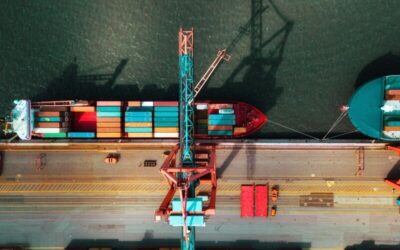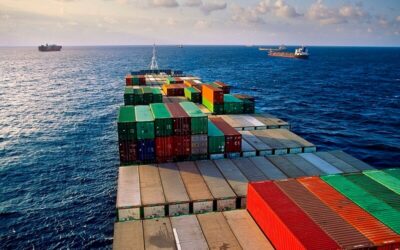The Biggest Supply Chain Challenges of 2021
Table of Contents
The growing demand for imports and exports due to advanced transportation technology is constantly bringing up unique supply chain challenges. Over the years, supply chain managers and companies have had to develop strategic plans, processes and, at times, completely overhaul their supply chain management departments.
With improved global supply chain standards due to giants like Amazon, Alibaba, etc it’s hard to keep up for the rest of the world. The slowed digital transformation and the lack of actionable data and insights from 2020 due to the coronavirus pandemic has further disrupted global supply chain operations.
The blowback on supply chain networks from 2020 has companies aiming for sustainability, flexibility, and end-to-end visibility in 2021.
In this article, we’ll focus on the three biggest supply chain challenges of 2021 and how you can strategically tackle them.
Let’s dive right in.
Aiming for Sustainability
One of the biggest issues today is on the matter of sustainability – environmental sustainability, to be exact. While the idea has been floating around for decades, it has gained a lot of momentum in recent years, along with concepts like reverse logistics – reusing, refurbishing, and recycling used products.
Sustainable practices have their logistical and budget benefits, but supply chain managers have started considering them because of the consumers. According to an essay published by The Economist, 85% of consumers are more likely to purchase from a business that focuses on sustainability.
As a result, businesses have started to focus on reducing their carbon footprint and adopting sustainable practices. And that includes using sustainable supply chain networks to minimize environmental damage.
That’s why a lot of businesses have turned to sustainable supply chain management solutions like Qafila which lights up dark areas in your supply chain and hence reducing extra steps in the supply chain by leveraging technology for visibility and digitally drive efficiencies toward being more sustainable.
However, a lot of supply chain leaders still struggle to find a cost-effective process towards sustainability.
Also Read: Air And Ocean: Logistics Challenges & Trends In [2021]
How to Tackle this Challenge?
Tackling the issue of sustainability isn’t something straightforward; it requires systematic industry-wide change and supply chain planning. If you weren’t opting for sustainable practices before, you would need a complete overhaul of your supply chain strategy.
Here are a few things you can do to get started.
Create a Supplier Code of Conduct
As a business, you obviously get your raw material from a supplier/several suppliers. Or you’re the supplier yourself, but even then, you get your resources from somewhere. In any case, if you’re looking to become more sustainable, you have to surround yourself with sustainable partners.
That means getting your raw materials from suppliers who also adhere to sustainable practices. The best way to go about it is to create a supplier code of conduct.
The supplier code of conduct ensures that your suppliers are environmentally friendly, responsible, and ensure safe working conditions for their employees.
For all intents and purposes, consider it an essential part of your supply chain management. That’s because it not only adds to sustainable practices but also ensures ethical practices.
Create a Training and Education Program
It’s no secret that the supply chain can improve customer experience, but to do that, you need to educate people on the best practices. The best way to do that is through training and education programs.
Similarly, the same concept applies to adopting sustainable practices in the organization. The first step is for supply chain managers to educate the employees under them and other organizational employees. After that, you have to focus on educating and training retailers, suppliers, and logistics providers.
Helping people understand the concept of sustainability and its advantages is a surefire way of setting up sustainable practices. Many people have a hard time adjusting to change; this is how you help them manage toward the new normal.
Track the Performance of Top Suppliers
Sustainability won’t help you much if you can’t get stability. Therefore, it’s crucial to track the performance of all your suppliers, especially the top suppliers.
Ideally, you’re looking for suppliers who can deliver the best results while maintaining sustainability practices. It’s possible your best supplier isn’t following any sustainable practices, and the ones that are don’t fulfill your supply.
That’s exactly why it’s critical to continually track the performance of your suppliers. You can help the top suppliers adopt better practices, or you can work with sustainable suppliers to get better supply services. In any case, tracking and working with your suppliers will help you move towards a better and more sustainable supplier relationship.
Partner with Industry Peers
You might have heard about omnichannel communication and the likes of it. The idea is to create a cross-channel communication platform to develop better relationships and improve user experiences.
It’s also a great way to ensure there are uniform sustainable practices along the supply chain, and more importantly that your audience knows the part you play in it.
A great way to achieve that is to partner with industry peers who have the same values and have adopted or are ready to adopt the same sustainable best practices.
Tackling Uncertainty with Resiliency and Flexibility
It’s no secret that 2020 brought out the worst of all supply chain risks. Extreme volatility, fluctuating customer demands, bad inventory management, and procurement shortages were just some of the major issues brought on by the coronavirus pandemic.
All of those issues can be summed up into one word – uncertainty. Uncertainty was the biggest supply chain challenge of 2020, and it carries on into 2021 for the foreseeable future.
You may think that uncertainty is always present, and that’s true, but never had it exacerbated to such lengths before. Consumer demands were constantly changing, product development came to a halt, and thousands of businesses rushed to computerized systems like ERP as they had to let go of their staff.
Experts predicted that more than 50% of manufacturing supply chains would be making direct-to-consumption shipments and home deliveries by 2020. Well, that didn’t happen.
The entire year gave supply chain managers a unique learning opportunity on how to deal with global emergencies. In the face of unprecedented uncertainty, you can’t afford to have lackluster decision-making, subpar forecasting, and one-size-fits-all solutions.
Going into 2021, it’s crucial to tackle supply chain uncertainty with unwavering resiliency and flexibility. What does that mean?
Tackling the Uncertainty Challenge
Uncertainty is simply the lack of actionable data based on current and future trends. We now know how global emergencies and nationwide shutdowns can affect the supply chain ecosystem and what metrics are affected.
The overall downturn gave way to new competencies, cost-effective solutions, and automation across platforms. It also paved the way for third-party logistics and even fourth-party logistics.
As a result, we’re already seeing unique market instances like the effect of blockchain on the logistics industry, new technology in the e-commerce space, and more.
The global supply chain industry has adapted to the dynamics of 2020’s issues and developed a rough system of tackling uncertainty. Here’s a 2-step process that you can get out of it.
Create a System for Data Collection
Notice all the businesses that were least affected by the pandemic. You’ll observe a similar pattern – they all had really robust data collection systems.
No matter what industry you’re in, the more data you have regarding your industries, trends, and audiences, the more actionable insights you can get out of it. The better your insights, the better decisions you can make, minimizing your uncertainty.
Therefore, the first step to reducing uncertainty is by creating a system of data collection on all fronts. That means, create a data collection system for the manufacturing, production, employee, and consumer side.
You would need to figure out data sourcing, analysis, and evaluation. Implementing artificial intelligence into the mix would help collect and analyze data more efficiently and quickly.
In any case, a complete system of real-time data collection is the first step.
Leverage Predictive and Prescriptive Analytics
After you’ve developed your data collection systems or adjusted them accordingly, you have to properly leverage that data.
This is where new technology comes in because the next step is to use predictive and prescriptive analytics.
Predictive analytics is when you use historical data, current trends, and advanced analytics to predict uncertain future events. A collection of statistics, data mining, data modeling, machine learning, and artificial intelligence techniques are used to analyze the data to develop accurate predictions of the future.
That’s how you can somewhat predict future global emergencies and work on predictive contingencies.
Prescriptive analytics uses machine learning to assist in the decision-making process by leveraging predictive analytics.
Therefore, predictive analytics will give you an accurate idea of future possibilities, and prescriptive analytics will help make the right/best decision based on the data.
Most importantly, creating an environment for sharing data, experiences, and best practices after this would help with traceability and visibility.
Acquiring End-to-End Visibility Both Upstream and Downstream
Out of all the supply chain challenges, end-to-end visibility has proven to be the biggest challenge for most supply chain professionals. Even with the latest technology, tracking systems, and digital platforms, it’s tough to have a pulse on your supply chain at all times.
True end-to-end visibility is achieved when you’re receiving real-time data from every supply chain area.
The concept of visibility gets harder to grasp if you’re using someone outside of your ecosystem like 3PL and 4PL. and if you are using multiples of them. However, if your organization is large enough to manage the entire supply chain, you’ll have an easier time acquiring end-to-end visibility within your ecosystem. But let’s be real, the majority of companies don’t have absolute control over their supply chain.
If you have control over the upstream operations, you might not have complete control over the downstream operations and vice versa.
That’s why there has been a growing insurgence of cloud computing in supply chain management. The best way to achieve end-to-end visibility is to have your supply chain operators who are digital-first like Qafila. If you can get something like end-to-end visibility integrated into your SCM platform, it would be easy to manage supply chain operations.
Acquiring True End-to-End Visibility
While opting for a digitized SCM platform is the best and shortest way to achieve end-to-end visibility, there are a few other things you can and should do.
A combined effort of it all would solve one of the most eluding supply chain challenges. More importantly, it would empower companies to become more resilient and improve overall transparency, eventually making it easier to adopt sustainability across the supply chain process.
So what can you do to get started?
Use IoT Technology
The concept of IoT (Internet of Things) has gained momentum in recent years as we achieve a more collective system across all fronts.
IoT is simply a system of connected objects, appliances, and digital networks that are connected through the internet over a wireless network without any human interaction.
In other words, you are bringing all your electronic devices online under a singular system. The reason this is revolutionary in supply chain management is that it would give you absolute control over the entire process at all times.
Modern warehousing is automated, logistics is automated, and most systems run on dedicated software. Bringing all of that together through IoT optimization would give you control over all supply chain areas simultaneously.
The use of digital twins has been complementing IoT systems in recent times. A digital twin is basically an online or digital representation of your assets, equipment, facilities, or process. Digital twins use real-time data and other sources to showcase any object or process across its lifecycle.
That, in turn, allows you to analyze data, monitor systems, prevent downtime, and develop new opportunities for systems by leveraging simulations.
As a result, you have the entire supply chain process at your fingertips as long as you have an internet connection.
Leverage RFID Chips
To achieve true IoT, you need to be able to track each element and asset. You can do that by installing RFID chips – using the sensors and internet connectivity, you can bring all your assets to a central network.
Bringing all of your devices under a central network is the best way to track them in real-time. That means, if you need to find out how a specific device is doing at any time, all you need is that device’s name or unique RFID.
Collaborative Logistics – Getting Everyone Onboard
Similar to how most new things and new products are introduced, you need to get people on board. Labor plays an important role in the supply chain, and it’s crucial to maintain worker satisfaction and retention.
If you’re introducing a new system or any changes in the logistical process, you have to ensure every employee understands the change. Tie this in with the training and education programs for sustainability so your employees can understand why you’re bringing about this change too.
Similarly, you also need to get other stakeholders on board too. It has been known for a while that integrated freight collaboration tools improve visibility across all fronts. That’s why there has been an increasing demand for freight brokers over the years.
In any case, collaborative logistics ensures everyone in the supply chain has access to relevant data at all times. Thus, bolstering and acquiring end-to-end visibility.
Wrapping It Up
While 2021 is mostly carrying the supply chain challenges from 2020, there are better ways to tackle those challenges at this point.
Sustainability, uncertainty, and end-to-end visibility have been the biggest challenges last year and will continue to be this year. However, by leveraging data collection systems, technology, and central supply chain dashboards, you can tackle all of these challenges.
Depending on your industry and your organization’s size, you may have slightly different processes. However, it all comes down to tackling each challenge systematically and gradually.
The best way to go about it is to bring all your supply chain processes under a central system where you can monitor each element in real-time.






